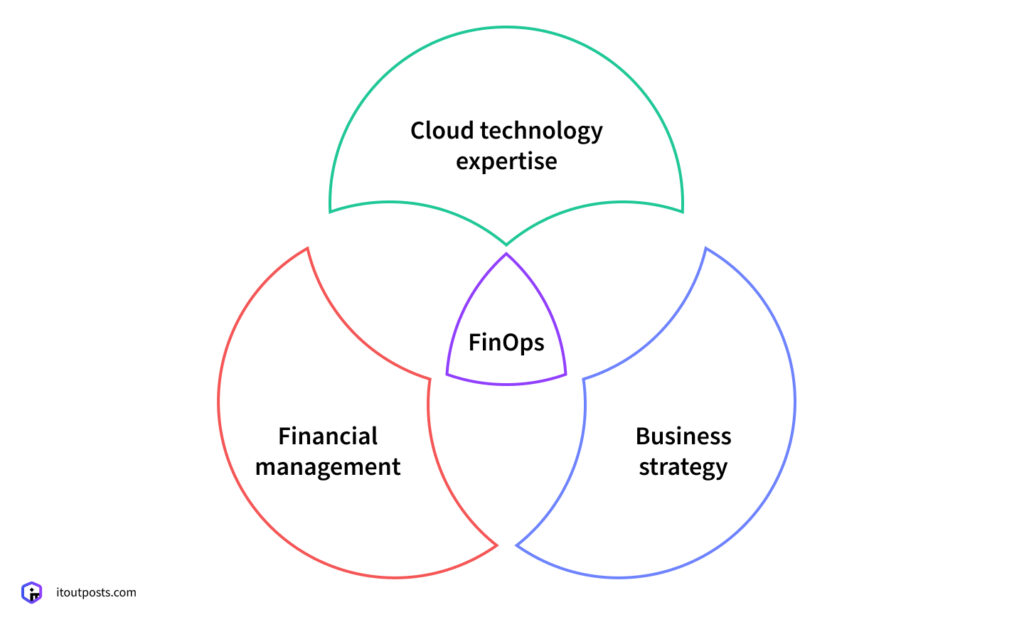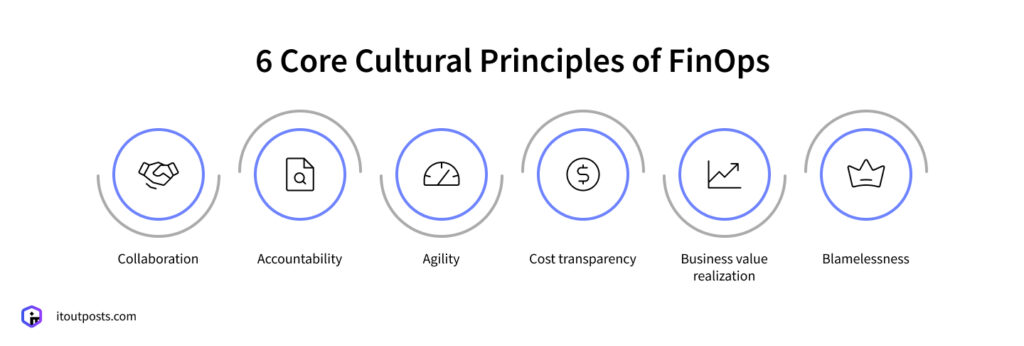Contents
So many terms end with “Ops” these days — DevOps, DevSecOps, MLOps. If you manage workloads in the cloud, you might have heard of another one: FinOps. But why do these terms appear constantly? Simple: tech is getting more complicated.
More details about the differences between DevOps and MLOps.
And so, the current cloud becomes even more complex as time goes on. It’s about computing power, databases, AI services, content delivery, serverless functions, and many other services. Not to mention different cloud pricing models, like pay-as-you-go, spot pricing, preemptible pricing, reserved instance pricing, and tier-based pricing.
The mix of services and multiple pricing options is exactly why we need FinOps, at least to save budgets but also to… Let’s explore all the benefits of the FinOps framework in this article!
What Is FinOps?
FinOps is a set of best practices and cultural changes aimed at helping organizations get the most out of their cloud investments. It combines financial management, cloud technology expertise, and business strategy to bring transparency and control to cloud spending.

The name comes from combining “Finance” and “DevOps,” and it perfectly shows how this framework ties financial responsibility to cloud operations.
6 Cultutal FinOps Principles
FinOps is a whole new way for organizations to reconsider their cloud expenses. Teams stop asking, “How do we cut costs?” and start asking, “How do we invest our cloud budgets for maximum value?”
Let’s discover the six core principles that make this cultural shift possible:
- Collaboration. Just like DevOps, FinOps breaks down traditional barriers between teams. Finance experts, developers, and infrastructure specialists work together daily. They share knowledge, make decisions together, and solve cloud cost challenges as one team. Each group brings different perspectives that let them optimize cloud spending.
- Accountability. Teams take ownership of their cloud costs. They track clear metrics that show how their cloud usage creates value. This way, teams can quickly determine how to optimize their resources and justify their spending.
- Agility. Cloud spending becomes adaptable and quick to respond to. Instead of sticking to fixed yearly budgets, teams modify their resources as demands change. They make speedy choices about scaling operations up or down. Planning turns into a continual process that adjusts according to real business needs.
- Cost transparency. Everyone gets a clear and real-time view of cloud costs. Both executives and engineers can access detailed spending information. This empowers them to make smarter choices about resource usage and recognize how their decisions impact costs.
- Business value realization. Every cloud decision connects to business goals. Teams don’t just look at technical metrics or cost numbers. They evaluate how cloud spending contributes to improved customer service and higher revenue.
- Blamelessness. When costs spike, or mistakes happen, teams don’t point fingers. They use these situations to enhance processes and prevent future issues.
The big takeaway about FinOps is that it’s not just about cutting cloud costs. The true strength lies in turning cloud spending into a smart strategy. At times, FinOps might even recommend upping cloud investment in areas that spur business growth. The aim is to spend more wisely, not just less. But, ultimately, this investment has to lead to tangible business results, like quicker time-to-market, enhanced operational efficiency, better customer satisfaction scores, and, of course, higher revenue.
Once we’ve touched on the FinOps benefits, let’s elaborate on them in bigger detail.

Advantages of FinOps
The impact of FinOps directly affects business performance. Here’s how.
Faster Market Response
When market conditions shift, companies can quickly tweak their cloud resources. They scale up fast to capture opportunities without overspending. During slower periods, they reduce costs without disrupting services.
FinOps makes all this happen with automated monitoring and straightforward scaling policies. Teams set up automatic alerts for when usage goes up or down. They establish preset rules for scaling resources based on demand patterns. Engineers and finance experts agree beforehand on scaling limits and budget caps, which cuts out any waiting for approvals.
Better ROI on Cloud Investment
Companies are finally able to put an end to the wondering of what they actually get for their cloud spending. They track how each cloud service contributes to business goals. This allows them to shift money from low-value services to high-impact areas. Teams can prove the business case for cloud investments with real data.
Increased Profitability
FinOps helps keep profit margins healthy even as cloud usage goes up. It spots waste before it hits the bottom line. When companies roll out new features or enter new markets, they can reliably forecast and manage their cloud costs. This keeps their profit margins safe during expansion.
While Theory Sounds Great, How Does FinOps Work in Practice?
Every company has its own way of doing FinOps. Some start with just one team or cloud service provider, while others upgrade the whole organization at once. Regardless of approach, successful companies follow similar steps.
Cloud Assessment
Organizations start by mapping their entire cloud landscape. Teams analyze spending patterns across all cloud services and accounts. They identify who uses which resources and why. This phase reveals unexpected costs, unused resources, and opportunities for optimization.
This analysis should answer the following questions:
- Which services cost the most?
- How do costs align with business value?
- Where is spending growing fastest?
- Which teams use which resources?
- What are the peak usage periods?
Building Visibility
After assessment, teams need ongoing visibility into cloud usage. They must choose appropriate monitoring tools.
Native cloud provider tools work well for single-cloud environments and basic needs. They offer built-in cost tracking, usage metrics, and basic forecasting. But if you need something more specialized, consider third-party platforms.
Resource Optimization
The outcome of the assessment will be several optimization strategies you can follow, including but not limited to the following:
- Rightsizing is all about making sure you have just the right amount of resources for what you actually need. You should analyze CPU, memory, and storage usage patterns to identify overprovisioned resources. For instance, a database could only need half of what it’s currently using.
- Eliminating idle resources. This approach targets resources that continue running without providing value. This might be dev environments that stay on overnight, old test instances nobody uses, or storage that’s collecting dust. You can simply set up automated schedules for non-production resources and reduce waste.
- Commitment-based discounts offer substantial savings in exchange for longer-term commitments. Reserved instances or savings plans can significantly lower costs compared to on-demand pricing. You just need to match commitment types to workload patterns.
- A multi-cloud strategy means using different providers based on cost-effectiveness for specific workloads. While AWS or Azure might handle your important production services, you could run development and testing on cheaper providers like Hetzner. However, this approach requires careful management of data transfer costs and operational complexity.
An experienced DevOps service provider, like IT Outposts, can help you decide on your ideal path to optimized cloud spending.
Continuous Monitoring and Improvement
Remember that agility is a core principle of FinOps? This particular stage illustrates how useful it can be. Annual budget reviews or quarterly planning isn’t the case here. FinOps promotes constant adaptation to changing conditions. You refine cloud strategies in real time as business requirements shift.
How IT Outposts Approaches FinOps
IT Outposts is a DevOps service provider that assists businesses in accelerating progress by building strong technology foundations. We bring expertise in modern cloud technologies, Kubernetes, site reliability engineering, and more.
Our FinOps approach is flexible and adapts to different scenarios, whether you’re considering your first cloud migration or want to optimize existing cloud infrastructure.
Thinking about moving to the cloud? We’ll show you what it means for your budget. Our team will assess if cloud migration makes financial sense for your business. We’ll calculate potential costs, identify risks, and create a clear migration budget. This will let you determine if moving to the cloud is the right choice for your business.
Already using the cloud? We’ll help you spend less while getting more. Our engineers will set up systems that automatically adjust to your needs. When costs start rising, you’ll know right away. Plus, we know how to get the best deals from cloud providers.
Check out some of our success stories in cloud optimization.
Vidby
Vidby runs complex AI models for their video translation service, but they faced a challenge. The matter was that their AI models needed powerful GPU nodes, and they cost ten times more than regular cloud servers.
Our team came up with a plan. First of all, we locked in a three-year deal with the cloud provider, which significantly reduced cloud costs.
Then, our team set up solid pre-launch planning for every new service. This way, Vidby can determine what resources and costs they need before rolling out new features.
Construction Planning Leader
Our client helps construction companies plan large industrial projects with tools for virtual design, cost estimating, and workforce planning. However, their Azure virtual machines kept experiencing downtimes, disrupting service for their end users and leading to revenue losses.
So, our team switched their setup from virtual machines to Kubernetes in Azure. Yes, it made costs a bit higher at first but also came with benefits. The upgraded infrastructure gave our client precise control over their resources and dramatically reduced service disruptions. The investment paid off through improved performance and fewer emergency fixes.
C-Teleport
C-Teleport makes marine travel bookings simple for businesses. As their platform expanded, they had to find a balance between keeping costs low and ensuring great service. Every dollar they spent on cloud resources had to help their booking service directly.
The company already had a smart multi-cloud setup — they used AWS for their production workloads thanks to its reliability and Hetzner for their development environments since it’s cheaper.
Our team stepped in to optimize their setup even more. We put in place detailed monitoring and tracking for resource usage. Plus, our team established retention policies for metrics that automatically get rid of monitoring data after 30 days, so they only keep what’s necessary for troubleshooting and spotting trends.
Final Say
We need FinOps. At least to save budgets but also to turn cloud spending into a strategic advantage.
Cloud costs shouldn’t control your business — you should control them. FinOps gives you this power. It helps you spend wisely on cloud resources that truly matter for your growth.
Ready to get more value from your cloud investment? Let’s explore how FinOps can help your business thrive. Contact IT Outposts today to start your FinOps journey!

I am an IT professional with over 10 years of experience. My career trajectory is closely tied to strategic business development, sales expansion, and the structuring of marketing strategies.
Throughout my journey, I have successfully executed and applied numerous strategic approaches that have driven business growth and fortified competitive positions. An integral part of my experience lies in effective business process management, which, in turn, facilitated the adept coordination of cross-functional teams and the attainment of remarkable outcomes.
I take pride in my contributions to the IT sector’s advancement and look forward to exchanging experiences and ideas with professionals who share my passion for innovation and success.